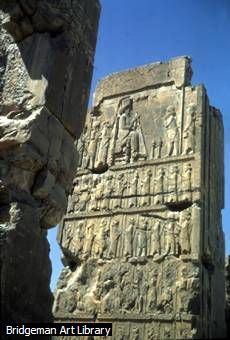.
Based on Merriam-Webster's
Collegiate® Dictionary
Use the BACK button
on your browser to return
Darius I, called
The Great (558?-486BC), king of Persia (521-486 BC) (we know as Iran today)
 the
stone carving depicts Darius I, right, also known as Darius the Great,
and his son and successor Xerxes I. Darius I ruled the Persian Empire from
about 521 to 486 BC. He secured the outer borders of the empire and reformed
its internal organization, built highways, encouraged commerce, and organized
a postal system. Darius allowed freedom of worship among the many different
ethnic groups in the vast empire, earning their respect and goodwill. the
stone carving depicts Darius I, right, also known as Darius the Great,
and his son and successor Xerxes I. Darius I ruled the Persian Empire from
about 521 to 486 BC. He secured the outer borders of the empire and reformed
its internal organization, built highways, encouraged commerce, and organized
a postal system. Darius allowed freedom of worship among the many different
ethnic groups in the vast empire, earning their respect and goodwill.
. This
relief is part of the ruins of the Palace of Darius, Persepolis, Persia. The palace
was built during the Achaemenian period, from 518 to 460 BC. The pillars
were carved out of limestone, and the design of the reliefs was influenced
by Assyrian sculpture. The relief probably shows Darius receiving gifts
from his subjects.
is part of the ruins of the Palace of Darius, Persepolis, Persia. The palace
was built during the Achaemenian period, from 518 to 460 BC. The pillars
were carved out of limestone, and the design of the reliefs was influenced
by Assyrian sculpture. The relief probably shows Darius receiving gifts
from his subjects.
This stone vase, probably made
during the Acaemenian period (550 to 331BC), has a foot, cap, and spout
all made of cast bronze. The letters on the body of the vase stand for
the Medici family, who apparently bought this piece in the 16th century
and remounted it, adding their initials.

Microsoft®
Encarta® Encyclopedia 99. © 1993-1998 Microsoft Corporation. All
rights reserved.
.
I n d e x o f
s i t e
.
|